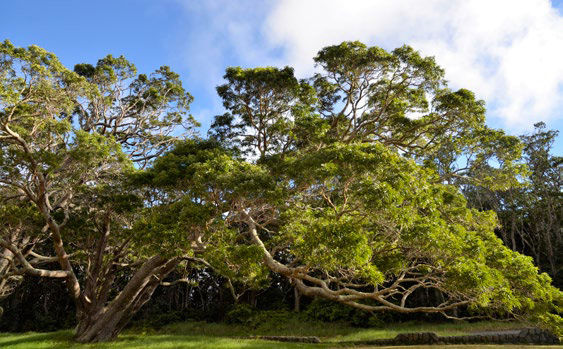THE KOA TREE — Acacia koa is its scientific name — has long been prized in Hawai`i, its wood once reserved strictly for royalty. The word “koa” means warrior in the Hawaiian language and indeed, the canoes that Hawaiian warriors sailed to conquer the island chain were made from koa, as well as some of the weapons they used in combat. Today, replica Hawaiian weapons are still made utilizing koa wood lashed to shark’s teeth or marlin bills, the devastating effect of the weapons belied by their simplicity and artistic appearance.
Koa was also used to make the first surfboards in the islands, magnificently turned calabash bowls and other household items, and later the first `ukuleles.
“Koa wood is associated with Hawai`i much like redwood is associated with the great forests of California or ebony wood with Africa,” says master wood- worker P.F. “Ski” Kwiatkowski. “The koa tree is the embodiment of Hawaiian forest deities, and much revered.
“Specific rituals are observed when taking a tree. When a canoe was being built, for example, a kahuna would spend weeks in preparation and days camping in the forest to observe. If he saw elepaio birds — a small brown bird with white wing bars and tail tips that is endemic to Hawai`i, inhabiting mainly the upland forests — land in a tree, he knew that tree had bugs and wouldn’t be suitable.
“Once the perfect tree was selected, a ceremony would take place to consecrate it. Much chanting would ensue and a pure black pig was sacrificed. It was giving one life for another. In this way the spirit of the tree would live on in the canoe that was built using its wood.”
Most koa trees nowadays are found on private or state-owned lands. The trees are endemic to the islands and are found primarily on Hawai`i Island, Maui, and O`ahu, with smaller concentrations in the upland areas of Kauai. Koa is not endangered and, according to recent studies, there is more koa growing in Hawai`i now than 10 or 20 years ago. While it might not be rare, it is expensive, mainly because it is di cult to obtain. Trees cannot be harvested on state lands by law, and private landowners are mostly holding onto their trees, often as investments for future generations. Thus, the price of a board foot starts at $20 and runs to $100 per board foot for premium, instrument-quality wood.
 According to Kwiatkowski, a koa cabinet or dining room table now can cost upwards of $2,500, and a new canoe might cost $100,000, particularly if premium curly koa is used. There are several designations of wood, depending on color and amount of “curl” (the swirly features of the wood’s grain). The variations are caused by the age of the tree, the weather conditions, and the soil and elevation where it is found. (Elevations between 3,500 to 4,500 feet are considered the Goldilocks Zone for koa wood.) “Koa has all the qualities that people want,” Kwiatkowski says. “It’s a good-looking wood with a rich history that makes solid furniture. Koa doesn’t grow on trees … it is the tree.”
According to Kwiatkowski, a koa cabinet or dining room table now can cost upwards of $2,500, and a new canoe might cost $100,000, particularly if premium curly koa is used. There are several designations of wood, depending on color and amount of “curl” (the swirly features of the wood’s grain). The variations are caused by the age of the tree, the weather conditions, and the soil and elevation where it is found. (Elevations between 3,500 to 4,500 feet are considered the Goldilocks Zone for koa wood.) “Koa has all the qualities that people want,” Kwiatkowski says. “It’s a good-looking wood with a rich history that makes solid furniture. Koa doesn’t grow on trees … it is the tree.”

